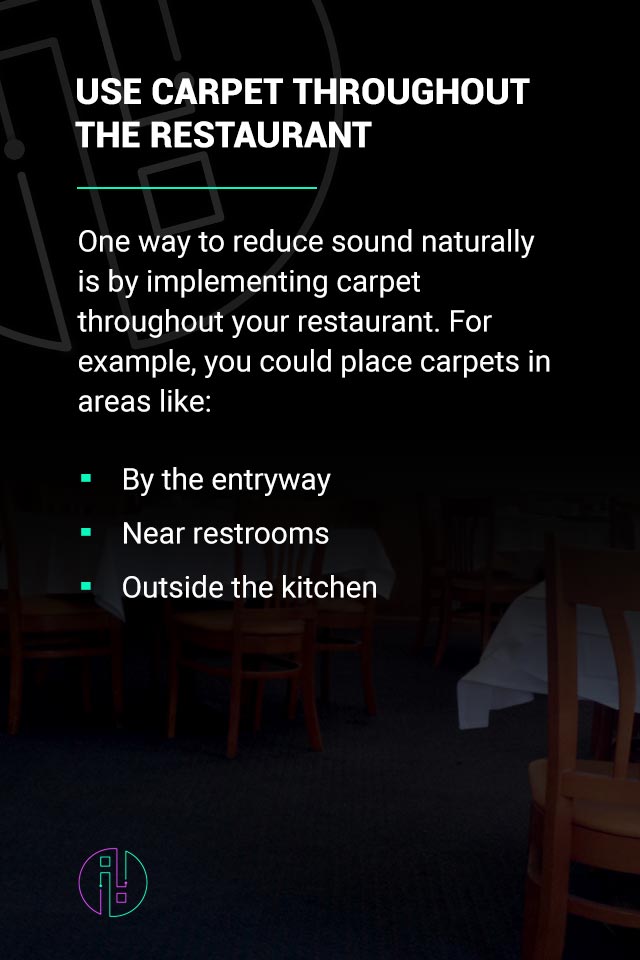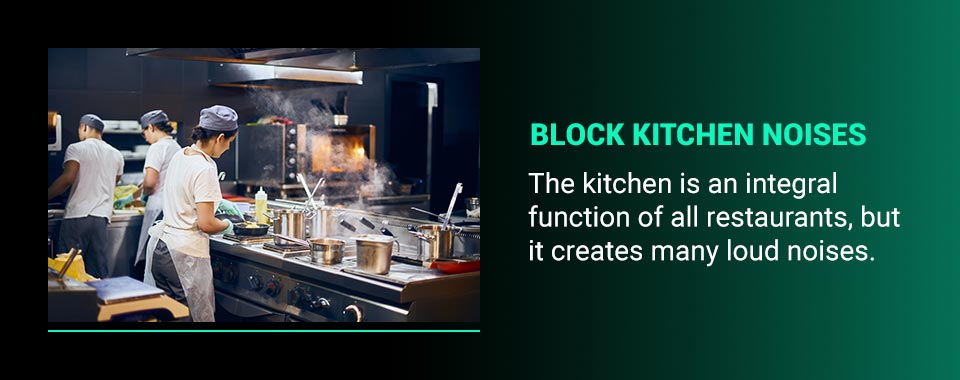

Restaurants are excellent social hubs. Customers can relax, catch up with one another and share the delicious food of their choosing. Whether breakfast, lunch or dinner, guests get to take in the atmosphere and enjoy their cuisine.
As an owner in the restaurant industry, one of your biggest goals is to create a pleasurable dining experience. However, excess noise is one of the most significant detractions from this goal. From chairs scraping across the floor to hammering background music and everything in between, a restaurant can be a noisy place. If there’s too much noise, it can negatively affect both staff and guests.
It’s important to reduce restaurant noise to optimize a customer’s experience.
Restaurants can get loud due to a variety of factors. Between the chattering customers, the busy kitchens and the many machines located throughout, things can get noisy fairly quickly. Without attention, some of this noise can get out of hand.
These are other examples of noisy stimuli in restaurants:

If you notice your restaurant’s noise levels are becoming too high, it might be time to consider new ways to manage them. You want to ensure your customers have a great experience so they spread the good word to others. Keeping noise at a manageable level contributes to a positive experience.
Despite all of the noise in a restaurant, there are many ways to reduce it. By trying new and creative strategies for noise reduction, you can improve the overall atmosphere. Read on for nine ideas for restaurant noise control.
Music is a central aspect of restaurants. You can appeal to your target customers and create a desired atmosphere with the right soundtrack. However, it’s important to view your music as background entertainment rather than the most important element customers need to hear. If music grows too loud, it can become overwhelming. Customers should be able to listen to one another during conversations, and restaurant workers must communicate comfortably.
You don’t have to remove music from your restaurant to maintain the noise levels. Instead, try lowering the volume one or two notches. You want a balance where you can still hear the music, but it’s not overpowering. Experiment with the sound levels until you find a preferable atmosphere for your restaurant.
You can also use customer feedback to gauge the best music volume. If a customer notes the music is too loud or soft, use their feedback to update it. Try to arrive at a consistent sound level for each day to establish a cohesive experience for customers each time.

One way to reduce sound naturally is by implementing carpet throughout your restaurant. Carpet has strong sound absorption qualities. It absorbs sound waves and other airborne noises, lowering the overall volume of your restaurant. These features make it a natural volume reducer, meaning you don’t have to make any significant changes to other sounds throughout the location.
Carpet is also available in many colors and textures, so you can select one that complements your overall theme. And, chairs and shoes make much softer sounds against carpet rather than hardwood.
You can implement carpet in small pieces if you don’t want an entirely padded floor. For example, you could place carpets in areas like:
Tablecloths are another fabric type that can reduce sound levels. When placed over customer tables, they can quiet some of the conversational noise. If every conversation gets quieted, the overall noise in the restaurant could lower.
As guests use silverware or place their glasses back on the table, the cloth absorbs some of the noise.
You can find tablecloths in a variety of colors, textures and thicknesses. You could choose a uniform color for each table or implement your own color scheme.
Some restaurants want to keep a specific atmosphere and feel that a carpet or tablecloth detract from this vibe. If you don’t want to install carpet or use tablecloths, consider adding insulation to your ceiling instead.
Here are some insulation ideas for your ceiling:
Your restaurant uses a lot of equipment to prepare meals and drinks for customers. While these machines are essential for food production, proximity to customers could be distracting. Many of these equipment pieces might be working at once during busy times, such as a dinner rush. All of these sounds combined can lead to an unpleasant or overwhelming sound that negatively impacts a guest’s meal.
Examples of these pieces include:
Consider reorganizing your machinery to ensure it doesn’t bother customers. Keep particularly noisy machines as far from guests as possible. For example, if you notice a blender causes discomfort in guests, move it further back into the kitchen to muffle the sound.
If possible, you could also relocate soda and ice machines further from dining areas. That way, customers can still fill their drinks without bothering conversations.

The kitchen is an integral function of all restaurants, but it creates many loud noises. From the various sounds of cooking to communication between staff, the kitchen can quickly become a noisy place. These sounds could contribute to your restaurant’s overall high noise levels if they’re not regulated.
For instance, some restaurants might leave the kitchen door open, so there’s no natural barrier between kitchen sounds and dining guests. The kitchen noises then blend with the other restaurant sounds, raising the volume of your entire space.
To prevent kitchen noises from affecting your customers, consider adding a barrier between the kitchen and dining room. Many restaurants use swinging doors that open easily but still provide separation between the two rooms. You could also add soundproofing panels to the kitchen doors to mask the noises further.
You can also add other soundproofing elements and accessories to manage sound in a noisy restaurant. These additions help absorb or deflect sound, which could lower the noise overall.
These are some examples of additional soundproofing materials:
These acoustic solutions help reduce noise naturally without any extra work.
Furniture also creates excess noise in restaurants. Tables and chairs scrape or thud on the floor, adding to noise levels. After extensive use, they can also squeak as customers sit. If your restaurant features free-standing seating, such as bar stools, these also create excess noise when customers push them in and out of position. These sounds are usually unpleasant and could detract from a dining experience if they happen too often.
Luckily, there are a variety of options available to quiet your furniture, such as:
Lastly, you could hire an acoustics consultant to help you find the best solution for your restaurant noise. These consultants offer industry expertise on the best ways to manage noise levels and reduce noise in your restaurant. They can also help you install acoustic systems or other devices that optimize the sounds in your restaurant.
To get the best results, acoustic consultants usually perform an inspection of your restaurant location and sound environment. During the inspection, they identify the areas that cause the most noise or echoes and recommend specific solutions that would best help your location. For instance, if they notice a high ceiling creates more sound issues, the consultant could work with you to add soundproofing materials to the ceiling or install an acoustic system.
If other strategies don’t seem to help, hiring a consultant is a great way to get direct advice from an experienced professional in the field.
Sound levels contribute so much to an overall restaurant experience. Bothersome or overwhelming noises can ruin a customer’s meal and might even cause them not to return. Restaurant staff must also hear clearly to record orders correctly and speak with other workers. A clear sound environment is crucial for the functioning of the entire restaurant.
At Illuminated Integration, we understand the necessity of sound management. We offer a variety of acoustic services that can help you manage your restaurant sounds. Our experienced designers provide extensive consultations, allowing your restaurant to find the optimal sound solutions.
To get started with Illuminated Integration, contact us to schedule a consultation today.